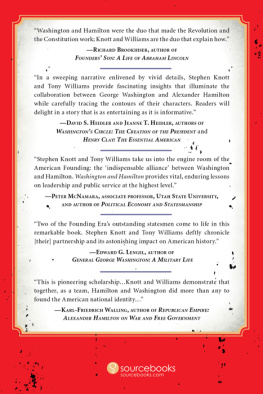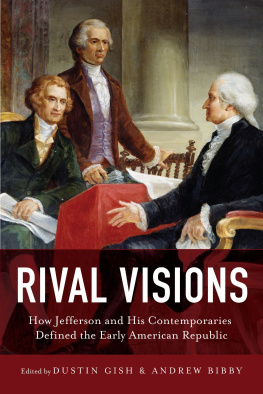The Ascent of George Washington: The Hidden Political
Genius of an American Icon
Almost a Miracle: The American Victory in the War of Independence
A Leap in the Dark: The Struggle to Create the American Republic
Setting the World Ablaze: Washington, Adams, Jefferson,
and the American Revolution
The First of Men: A Life of George Washington
Adams vs. Jefferson: The Tumultuous Election of 1800
John Adams: A Life
Struggle for a Continent: The Wars of Early America
Independence: The Struggle to Set America Free

To Lorene Flanders
and all those in the Irvine Sullivan Ingram Library
who have provided so much assistance over the years
Contents
The sun struggled to peek through the scudding winter clouds as Bill and Hillary Clinton strode briskly up the steps of Monticello, Thomas Jeffersons majestic mountaintop home outside Charlottesville, Virginia. It was January 17, 1993. Just three days away from becoming Americas forty-second chief executive, Clinton had chosen to embark on his inaugural festivities at the residence of his namesake, the nations third president.
The visitors were given a tour of the mansion, after which they joined a motorcade for the journey to Washington. When Clinton took office in a festive ceremony on January 20, he spoke of Jefferson in his inaugural address, describing the Founder as an apostle of change. Jefferson, said President Clinton, had believed in democracy and knew that periodic dramatic change was essential in order to revitalize our democracy and preserve the very foundations of our nation. To endure, Clinton said, America would have to change, but the changes must come within the framework of Americas ideals as set forth by Jefferson: life, liberty, the pursuit of happiness, and the equality of all humankind. As it had been during Jeffersons time, Clinton continued, each generation was compelled to define what it means to be an American.
Clinton returned for a second visit to Monticello only seventy-five days into his presidency, and throughout his term he spoke so often of his predecessor that a national news magazine referred to Jefferson as Bill Clintons muse. Clinton even enlisted Jefferson in the fight for national health insurance, avowing that Jefferson would be shocked to learn that not every American had access to affordable health care. As had Jefferson, Clinton said that he believed democracy would rise or fall not on the strength of some political elite, but on the strength of ordinary people who hold a stake in how our society works.
Clintons successor, George W. Bush, said little about Jefferson. Bush was drawn more toward a different founder, Alexander Hamilton. On May 30, 2006, a spring-soft morning in the capital, Bush walked from the Oval Office
George Washington was the one who made things happen, but while he was the prime mover in Revolutionary America, it was Alexander Hamilton and Thomas Jefferson, more than any others, who shaped the new American nation. The strong central government, our system of finance, and the industrial vigor of the United States are Hamiltons legacy. Americas bedrock belief in equality, its quest for novelty, and the continental span of the nation were bequeathed to succeeding generations by Jefferson.
Hamiltons and Jeffersons contrasting views on the shape of the new American republicits government, society, and economysparked a bitter rivalry. Furthermore, the ideas and issues that divided those two Founders have persisted from generation to generation in American politics. Their opposing views are like the twin strands of DNA in the American body politic. In the nineteenth century, partisans clashed over banks, tariffs, the money supply, and workers rights, among other things. In subsequent generations, political parties have battled over issues such as regulation of trade, the distribution of wealth and power, and governments role in health care. Always, however, the divisions in these battles stretch back to the fundamental differences that separated Jefferson and Hamilton: faith in democracy, commitment to civil liberties, trust in the wholesomeness of market forces, the availability of individual opportunities and security, toleration of dissent, the scope of the military, and above all, the depth and breadth of government intrusiveness.
Jeffersons and Hamiltons standing in the minds of Americans has hardly been constant. For decades following Jeffersons election to the presidency in 1800, a contest that spelled political ruin for Hamilton, the Virginian captured the hearts of Americans. All the while, Hamilton slid, if not into oblivion, at least into the dark shadows of history. The Democratic-Republican Party, or Democratic Party, as it was known by the 1820s, had been Jeffersons, and it was largely predominant until the mid-nineteenth century. A succession of Democratic presidents kept alive the memory of Jefferson as the
But a great shift occurred in the second half of the nineteenth century. The reputation of Jefferson, a Southerner and a slave owner, suffered nearly mortal wounds in the hearts of many Americans in the wake of Southern secession, civil war, and the repudiation of slavery. The standing of Hamilton, who had been a proponent of a strong national government, soared, and he ascended even higher in Americas pantheon of heroes as the country entered the Industrial Age later in the century. While treasury secretary, Hamilton had offered an alternative to Jeffersons agrarianism, ultimately making possible the explosive growth of the American economy. As the century ended, Hamilton was touted as the creator of modern capitalism and the first American businessman, and in 1900, when New York University established a Hall of Fame to honor eminent Americans, Hamilton was the first inductee.
Industrialization was a double-edged sword. It provided new social, cultural, and material opportunities, but wealth and power were soon concentrated in fewer and fewer hands. Giant corporations and important financiers exercised nearly unmatched political clout, while unprecedented numbers of Americans lived in squalor and coped with dangerous and exploitive working conditions. Jeffersons reputation rebounded, especially in the South and the Great Plains, home to farmers who saw themselves as victims of railroads, tariffs, and the fiscal policies of a national government in the grasp of corporate and financial giants. Jeffersons image took on renewed luster among those who feared his vision of an Arcadian America was vanishing before new hordes of Hamiltonians. William Jennings Bryan, the foremost spokesman for the oppressed farmers, was saluted in the 1890s as the Jefferson of today. In hundreds of speeches, Bryan exhorted his followers to espouse Jeffersonian principles with Jacksonian courage. He proclaimed that Jefferson had stood for equal rights for all, special privileges for none. Others who resisted privilege, monopolies, and centralized authority reminded their followers of Jeffersons sympathy with popular rights and his belief that all civil power should be exercised that the interest and happiness of the great mass of the people would be secured.
In the shadow of the first laudatory biographies of Hamilton, two editions of Jeffersons papers were issued beginning in the 1890s. They were accompanied by several favorable life histories. A veritable army of historians portrayed Jefferson as having stood for advancing the liberating tendencies unleashed by the American Revolution while Hamilton had represented the forces of reaction.
Busts, statues, and memorials of Jefferson sprang up across the landscape. Democratic Clubs sponsored a Jefferson celebration at Monticello in 1896, and the next year the Democratic Party inaugurated its Jefferson Day Dinner, which thereafter has been held annually on the anniversary of the Founders birthday. Attendees sang a song with lyrics proclaiming Jefferson the symbol of the nation who had stood for the Universal Brotherhood of Man. Many of the tributes to Jefferson portrayed each federal law that aided Wall Street and corporate America as a monument to the memory of Alexander Hamilton.
Next page





